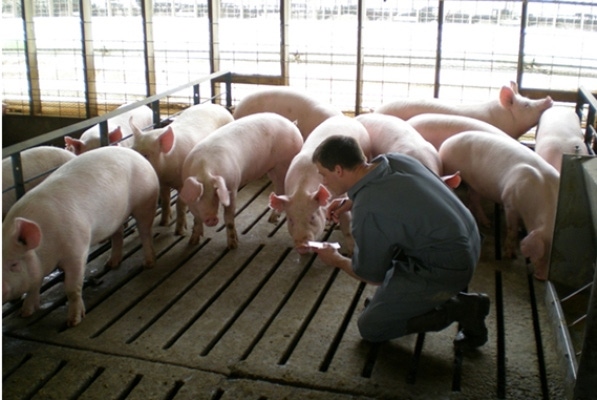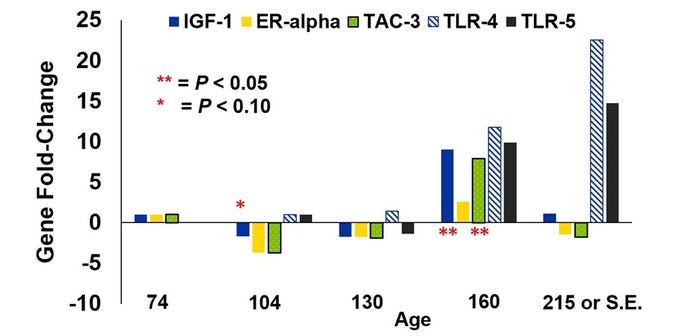Can we find the key to early estrus in gilts?
Changes that occur during gilt reproductive development may provide insight into females that will achieve puberty at a younger age.
March 16, 2023

Retaining females within a breeding herd continues to be a challenge for producers, with nearly 3 million breeding females being removed from the herd each year due to reproductive failure. Good reproductive performance in gilts can be defined with three criteria:
Successful pregnancy at the first breeding attempt.
A first litter of high-quality piglets (defined as piglet birth weight equal to the herd average).
At least two additional pregnancies.
In addition, females that achieve first estrus at a younger age are more likely to stay in the breeding herd longer and produce more high-quality off-spring. The ability to "weed out" the gilts that will have lower likelihood of reproductive success before puberty has the potential to reduce both labor and gilt development costs. However, there are currently no practical on-farm tools to predict which gilts, in the prepubertal stage, will achieve estrus at a younger age.
In humans, reproductive hormones, and the immune system work together within the reproductive tract for fertilization, implantation and recognition and maintenance of pregnancy. Changes in cell reorganization and structure in vaginal tissue coincide with serum hormone levels in prepubertal gilts suggest underlying changes during reproductive development that may be used as prepubertal marker.
We characterized changes in vaginal gene expression during gilt reproductive development in 13 gilts from 70 to 215 days of age (10 to 30 weeks of age). Vaginal epithelia were collected using a swabbing technique at five key timepoints during reproductive development [day 74 (growing), day 104, (mid-folliculogenesis), day 130 (post-folliculogenesis) and day 160 of age (start of boar exposure), as well as at first estrus or end of trial]. Of the 13 gilts, three exhibited estrus early (d169 to 171), three were average (d 194 to 195), two were late (d 203 to 213), three were deemed anestrus, and two had a silent estrus (one prior to d160 and one after d200).
Expression of genes involved in growth rate (IGF-1), reproductive development (ER-alpha and TAC3), and the immune response (TLR-4 and TLR-5) were determined. Expression of each gene at day 104, day 130, day 160, first estrus or end of trial was compared relative to 70 d of age which served as the "baseline." Expression of IGF-1 and TAC3 increased 9-fold and 7-fold, respectively, at the start of boar exposure (d 160; P
During expected folliculogenesis (d 104) expression of ER-alpha tended to be increased 3-fold (P = 0.08). Further support that measurable changes in gene expression were correlated with reproductive development was discovering that expression of TLR-4 and TLR-5 were not detected, or lowly detected in all samples at d 70, d 100, d 130 and d 160 (n = 0/13, 3/13, 2/13, and 2/13 samples). However, expression was readily detected in 8/13 samples at standing estrus.

The two females where TLR expression was consistently detected at d104, d130 and d160 expressed estrus prior to d 200. The vaginal TLRs act to prevent infection while allowing fertilization and implantation to occur and are critical to reduce immune and inflammatory responses. The high expression of these genes at estrus supports distinct alterations in vaginal epithelia in association with gilt reproductive readiness.
The increase in gene expression as gilts neared puberty (i.e., the start of boar exposure) further supports that changes in the reproductive tract, specifically in vaginal cells, occur throughout reproductive development, and increase prior to puberty. Considering these females and the selected genes, d160 may serve as a suitable timepoint for detection of markers for pre-pubertal selection of gilts. However, females at d 160 of age may be getting close to market weight, so being able to implement this prepubertal selection at an earlier stage in reproductive development will provide the producer more opportunity to optimize gilt selection and market unselected gilts at a more suitable weight.
To this end, d130 timepoint may serve as another potential opportunity for pre-pubertal marker identification. This pilot study successfully characterized changes in the vaginal gene expression as reproductive development progressed. Additionally, a broader screening of genes within the vaginal epithelium may help to identify the optimal biomarkers to help "weed out" gilts that may not achieve estrus as early as other females.
You May Also Like



